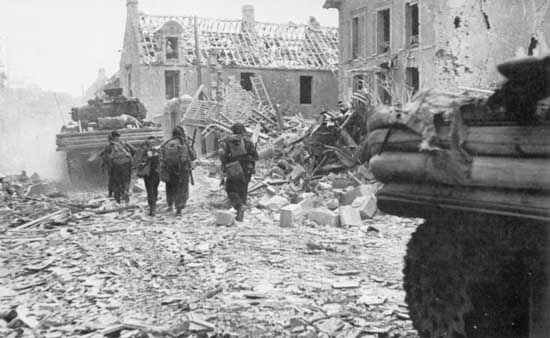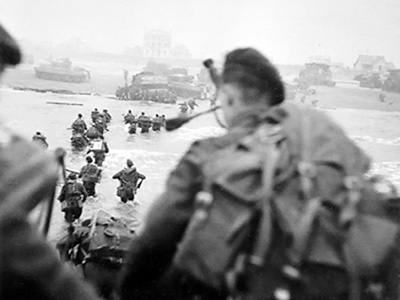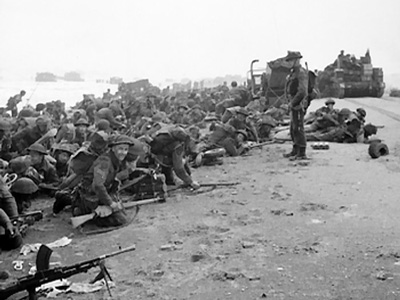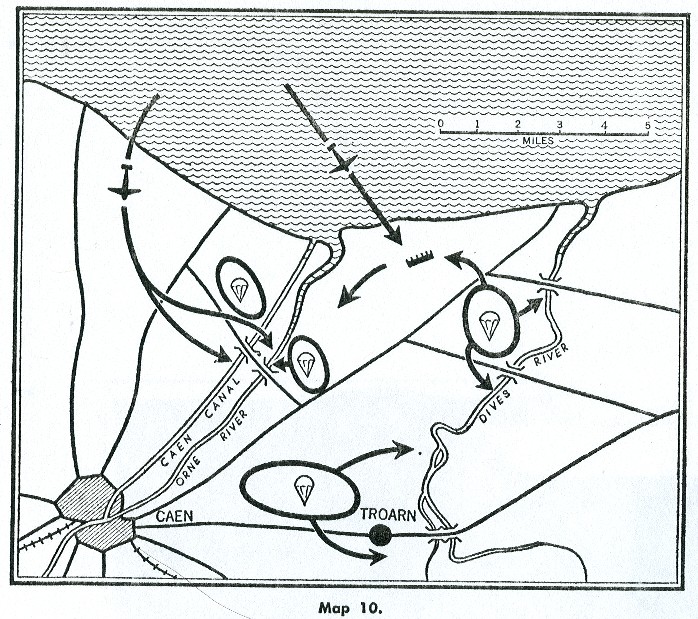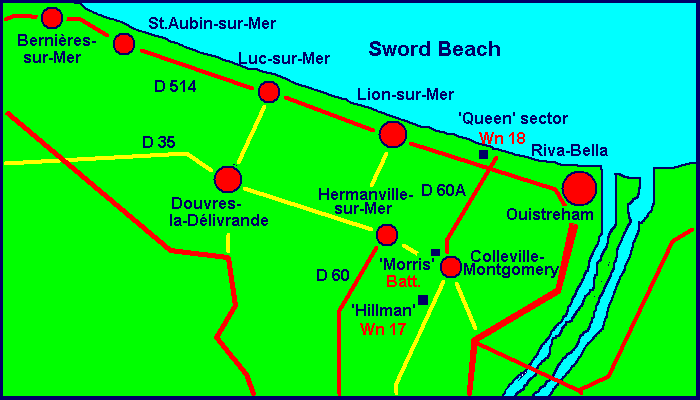Battle Report: D-Day Sword Landings Part 1: Luc-Sur-Mer
Dawn broke on the 6th of June 1944. The German lines at Luc-Sur Mer had taken a beating from Allied bombers overnight. One of the multi-story buildings on the waterfront had been all but destroyed, but the Ost Truppen huddled in the trenches and the bunkers remained unscathed.
" Herr Leutnant! Englischer Schiffe!" The junior officer visibly paled when he brought his binoculars to his eyes. As far as he could see the horizon was packed with ships. The next moment naval shells screamed overhead.
" Es fingt an..." - It has started, he said. Here's to hoping these Ost Truppen will hold!
The gamers rolled first for wild cards- the Luc-sur-Mer (LSM) sector of the board rolled improved skills for the Infantry: Went from reluctant trained to confident veteran, a useful roll. Allies rolled for extra armour support (+1 to rolls for armoured reinforcement landing)
Turn 1: The allies went first (as per the real battle): First a preliminary naval bombardment, which took out one of the Flak Vierling AA guns protecting the rocket launcher battery set in the fields beyond LSM.
The landing craft arrived, disgorging sappers on the beach, and calling in a flight of Hawker Typhoons. 3 aircraft made it to the area, and attacked the dug in troops in the trenches facing the beaches. The dug in Ost Truppen (now confident veterans) lost some platoons, but held, ready for the coming onslaught
Germans returned fire, taking out the lead sapper command group with their machine-gun fire and fire from the trenches. The sappers were unlucky enough to be just within the range of the nebelwerfers, which then proceeded to unleash a hail of death upon them. The survivors of the first wave were pinned down on the beach, and failed to reach the minefields and tank barriers they were attempting to destroy, to allow the masses of tanks in LCTs approaching in the second wave of landings.
Turn two saw some allied tanks make it to the beach- a unit of DD Sherman tanks. These waded out of the water before opening fire on the German emplacements. A heavy MG nest was taken out by this assault. The second wave of landing craft also deployed more sappers, who hurried up the beach, only to meet the same fate as those landed in the first wave.
These however had learned from their compatriots' misfortune, and stayed out of range of the rocket launchers. A single surviving troop of the first landing made it to the beach defenses, and started preparing the way for the next landing of tanks. The dug in static German Infantry, in trenches and buffed up to confident veterans withstood wave on wave of attack, with minimal casualties.
The Germans brought up a 37 mm AA gun mounted on a half-track to defend the infantry from the incessant harrasment by the RAF, only to find the fiendish pilots changing their flight path to avoid the German shells.
The 21st Panzer Army's Stug IIIs arrived from Caen, and moved towards LSM, to the cheers of the Heer artillery, who found that the clever Tommies stayed well out of reach of both the Nebelwerfers and LeFH18 fieldguns. The ruins of LSM also prevented the 88mm guns from drawing a bead on the tanks on the beach.
To relieved grins the 21. Pz Div started moving down the road towards the beaches. This time Allied Aircraft were intercepted on their way in, and did not arrive at the scene of the battle. More smiles from Herr Oberleutnant Rhyn von Rheenen zu Fischer, commanding the Panzer column:
Turn 3 saw the Allies land several more M4 Shermans from LCTs and also 2 Churchill AVRE bunker busters, as well as a Churchill VII onto LSM Beach.
They made short shrift of the 88 mm Gun emplacement and the 75 tank turret bunker guarding the beach approaches. Both went up in flames. They also carefully stayed out of reach of the rocket launcher range. The Germans in their turn successfully brought up a platoon of reinforcement PzKfw IVs from the direction of Caen, and went hammer and tongs at double time to try and get to the beach head, but it was a very looooong way from the back of the board !
Turn 4 saw the Allies still on the beach, though the beach defenses at LSM had now broken, all that stood between the allies were the trenches of the Ost Truppen of 716. Infanterie Division. Luckily these held, not withstanding another rocket attack by 2 typhoons, this time from the Lion sur Mer side of the beach, clearly to avoid the 37mm AA gun now parked near the trenches. The Allied commander landed more Shermans, and a unit of Wolverines at LSM, ready for the punch that would take them into the town, and beyond to the rocket launcher unit. All that stood between them and that objective was a thin grey line of dug in troops (in bullet proof cover), 3 PzKfw IVs, 2 Pak 40s, and 5 StuGs, who now seemed to be heading towards Ouistraham and the Orne River bridges.
The sun set all to soon, with the Allies still on the Beaches, and the objectives still in German hands. Technically a victory for the Germans, as the Allies were still trapped on the beaches. Given another turn or two a totally different outcome may have transpired. Pity we had to vacate the hall. Things were just getting interesting...
Tune in again for part 2 of our 3-part D-Day landing story: Lion-sur-Mer and Hermanville.
What did Herr General Oberst learn?
1. When you have artillery dug in to attack a beach, make sure that they are within reach !
2. We were limited in setting up our boards and terrain due to net getting access to the hall the previous night. The terrain was not entirely what I had planned or envisaged as a result, but it worked ok. We lost 2-3 hours' playing time, and couldn't finish our game due to the time constraints this causedt. The day went well though, despite all of this.
3. As an exhibition game it went well, giving several newcomers their first taste of wargaming, and for some a first time away from WH 40K:
" Es fingt an..." - It has started, he said. Here's to hoping these Ost Truppen will hold!
Luc-sur-Mer at Dawn 6 June 1944: German occupation troops dug in,
88mm Bunker and 75mm Tank Turret to theright, at left, Pillbox HMG and LMG,
rocket launcher battery and Pak 40s in fields beyond
Turn 1: The allies went first (as per the real battle): First a preliminary naval bombardment, which took out one of the Flak Vierling AA guns protecting the rocket launcher battery set in the fields beyond LSM.
The landing craft arrived, disgorging sappers on the beach, and calling in a flight of Hawker Typhoons. 3 aircraft made it to the area, and attacked the dug in troops in the trenches facing the beaches. The dug in Ost Truppen (now confident veterans) lost some platoons, but held, ready for the coming onslaught
The first British wave to land: Sappers of the 22nd Dragoons (3rd Inf Div)
Their task to destroy the beach defenses to allow the tanks to move into LSM
Germans returned fire, taking out the lead sapper command group with their machine-gun fire and fire from the trenches. The sappers were unlucky enough to be just within the range of the nebelwerfers, which then proceeded to unleash a hail of death upon them. The survivors of the first wave were pinned down on the beach, and failed to reach the minefields and tank barriers they were attempting to destroy, to allow the masses of tanks in LCTs approaching in the second wave of landings.
The Nebelwerfers dug in near the town's water supply unleash their deadly barrage on the beaches:
Ost Truppen and 88mm AA gun protecting their flank and frontal arc respectively
Turn 2: More sappers land and a flight of Typhoons deliver more death to the German trenches.
Well fortified and dug in, they survive the ordeal, but radio for AA support.
Where is " Der verdamte Luftwaffe? "
Turn two saw some allied tanks make it to the beach- a unit of DD Sherman tanks. These waded out of the water before opening fire on the German emplacements. A heavy MG nest was taken out by this assault. The second wave of landing craft also deployed more sappers, who hurried up the beach, only to meet the same fate as those landed in the first wave.
These however had learned from their compatriots' misfortune, and stayed out of range of the rocket launchers. A single surviving troop of the first landing made it to the beach defenses, and started preparing the way for the next landing of tanks. The dug in static German Infantry, in trenches and buffed up to confident veterans withstood wave on wave of attack, with minimal casualties.
The Germans brought up a 37 mm AA gun mounted on a half-track to defend the infantry from the incessant harrasment by the RAF, only to find the fiendish pilots changing their flight path to avoid the German shells.
The 21st Panzer Army's Stug IIIs arrived from Caen, and moved towards LSM, to the cheers of the Heer artillery, who found that the clever Tommies stayed well out of reach of both the Nebelwerfers and LeFH18 fieldguns. The ruins of LSM also prevented the 88mm guns from drawing a bead on the tanks on the beach.
To relieved grins the 21. Pz Div started moving down the road towards the beaches. This time Allied Aircraft were intercepted on their way in, and did not arrive at the scene of the battle. More smiles from Herr Oberleutnant Rhyn von Rheenen zu Fischer, commanding the Panzer column:
Turn 3 saw the Allies land several more M4 Shermans from LCTs and also 2 Churchill AVRE bunker busters, as well as a Churchill VII onto LSM Beach.
They made short shrift of the 88 mm Gun emplacement and the 75 tank turret bunker guarding the beach approaches. Both went up in flames. They also carefully stayed out of reach of the rocket launcher range. The Germans in their turn successfully brought up a platoon of reinforcement PzKfw IVs from the direction of Caen, and went hammer and tongs at double time to try and get to the beach head, but it was a very looooong way from the back of the board !
The deadly bunker-busting AVREs
Allied Armour about to crush the entrenched Germans, bunkers burning fiercely as shells start exploding in the German fortifications...but saved by the end of play.
The sun set all to soon, with the Allies still on the Beaches, and the objectives still in German hands. Technically a victory for the Germans, as the Allies were still trapped on the beaches. Given another turn or two a totally different outcome may have transpired. Pity we had to vacate the hall. Things were just getting interesting...
Tune in again for part 2 of our 3-part D-Day landing story: Lion-sur-Mer and Hermanville.
What did Herr General Oberst learn?
1. When you have artillery dug in to attack a beach, make sure that they are within reach !
2. We were limited in setting up our boards and terrain due to net getting access to the hall the previous night. The terrain was not entirely what I had planned or envisaged as a result, but it worked ok. We lost 2-3 hours' playing time, and couldn't finish our game due to the time constraints this causedt. The day went well though, despite all of this.
3. As an exhibition game it went well, giving several newcomers their first taste of wargaming, and for some a first time away from WH 40K:
Visiting 40K playes getting their first taste of FoW
Break-through on LSM Beach about to happen, tightly clustered armour from an inexperienced gamer offering a tempting target for the old hands, also now within range of the Nebelwerfers, and
3 PzKfw are about to come charging around the corner of the double-story holiday villa at right.
And then the sun set. Drat!



















-_D-day_6_June_1944_MH9509.jpg)












